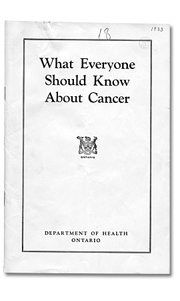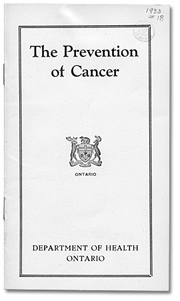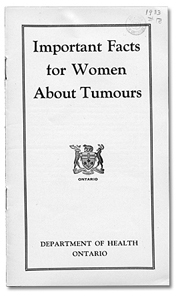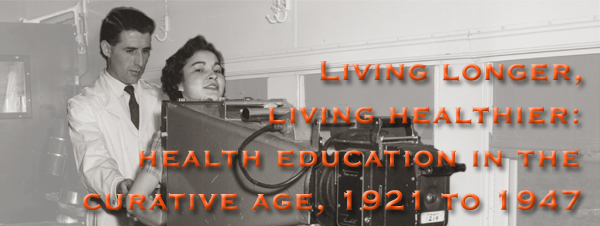
Table of Contents
Public health nurses: bringing health home
Living longer, living healthier: health education in the curative age, 1921 to 1947
Mass marketing and social change: the postwar era | Health promotion in the modern era: 1974 and beyond
The promotion of healthy living in Ontario: timeline
|
Certain diseases, such as smallpox and typhoid fever, were well controlled through vaccination efforts by the 1920s. Yet other diseases continued to claim lives. Tuberculosis - TB - proved to be the most virulent of these. Its devastation prompted the Provincial Board of Health to carry out a huge public awareness and prevention campaign, producing and distributing pamphlets, lectures, displays, and traveling exhibitions. |
||||||||||
![Photo: Tuberculosis exhibit at the Canadian National Exhibition (CNE), [ca. 1924]](pics/5217-posters-520.jpg)
Click to see a larger image (291K)
|
||||||||||
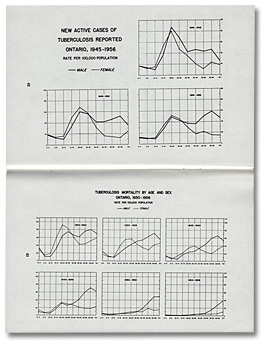
|
Most Canadians think that tuberculosis is a disease of the past - while it hasn't been entirely eliminated, TB certainly is a rarity in 21st-century Ontario. For decades, though, TB was an urban scourge. It claimed thousands of lives and touched families everywhere. In the 1920s and ’30s, TB seemed to affect every family. In 1908, regulations had been passed to try to control the spread of TB, including compulsory reporting of all known cases. But they had little effect.
Click to see a larger image (112K) |
|||||||||
|
||||||||||
|
|
||||||||||
|
In 1924, the provincial Health Department started the first traveling diagnostic clinic for TB. Free mass screenings at the chest clinics helped educate both doctors and the public about the prevalence and devastating effects of TB, taught people how to prevent the disease, and made everyone much more “tuberculosis-conscious.” |
||||||||||
![Photo: Woman being tested for tuberculosis on the Ontario Tuberculosis Association Chest X-Ray Train, [ca. 1950]](pics/5205-chest-x-ray-woman-270.jpg)
Click to see a larger image (128K)
|
![Photo: Man being tested for tuberculosis, [ca. 1950]](pics/5202-chest-x-ray-270.jpg)
Click to see a larger image (126K)
|
|||||||||
|
Although there had been TB sanatoria in Ontario since the late 1890s, more isolation and treatment centres were set up across the province. And public health officials went into both workplaces and schools across the province, testing for TB and distributing educational materials. |
||||||||||
|
Tuberculosis information booths were also set up at fall fairs such as the Canadian National Exhibition in Toronto, and in community halls in smaller centres.
Tuberculosis exhibit at the Canadian |
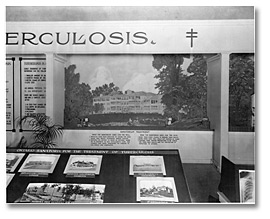 |
|||||||||
![Photo: People standing in front of an Ontario Department of Health Mobile Tuberculosis Testing Clinic, [ca. 1960]](pics/5213-mobile-testing-520.jpg)
People standing in front of an Ontario Department of Health Mobile
|
||||||||||
![Pages from The Sir Oliver Mowat Memorial Sanatorium pamphlet Kingston, Ont. : British Whig Publishing Co., [192-?], Pages 6-7](pics/40257-mowat-pamphlet-270.jpg) |
![Pages from The Sir Oliver Mowat Memorial Sanatorium pamphlet Kingston, Ont. : British Whig Publishing Co., [192-?], Pages 10-11](pics/40258-mowat-pamphlet-270.jpg) |
|||||||||
|
Pages from The Sir Oliver Mowat Memorial Sanatorium pamphlet |
||||||||||
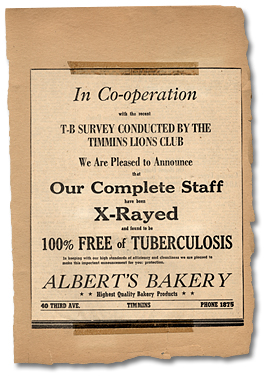
Click to see a larger image (403K) |
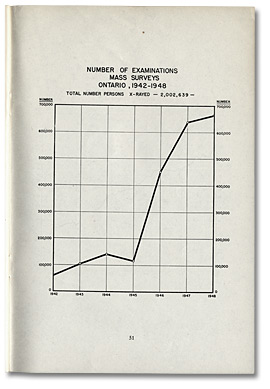
Click to see a larger image (99K)
|
|||||||||
![Photo: Exterior view of the Ontario Tuberculosis Association Chest X-Ray Train, [ca. 1950]](pics/5204-railcar-270.jpg)
Exterior view of the Ontario Tuberculosis Association Chest X-Ray Train, [ca. 1950] |
![Photo: Tuberculosis testing clinic, [ca. 1960]](pics/5210-testing-clinic-270.jpg)
Tuberculosis testing clinic, [ca. 1960] |
|||||||||
|
||||||||||
|
Like the impetus provided by the health challenges faced by veterans after World War One, in the ’20s and ’30s the threat of tuberculosis brought health education and promotion to a new level. And Ontarians responded. The Dominion Council of Health, at its 1939 annual meeting, took note of the public enthusiasm for health education: |
||||||||||
|
||||||||||
Advances in treatment helped Canadians become healthier too—new drugs and other medical advances began to prolong many people’s lives.
![Photo: Two men viewing a chest x-ray at a Board of Health laboratory, [ca. 1928]](pics/5238-chest-xray-520.jpg)
Two men viewing a chest x-ray at a Board of Health laboratory, [ca. 1928]
Ministry of Health
Reference Code: RG 10-30-2, 1.4.27
Archives of Ontario, I0005238
|
Previous | Home | Next |
